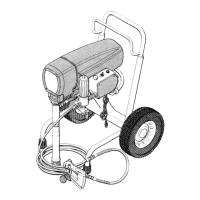WARNING’
Pressure Relief Procedure
To reduce the risk of serious bodily injury, in-
cluding injection or injury from moving parts or
electric shock, always follow this procedure
whenever you shut off the sprayer, when check-
ing or servicing any part of the spray system,
when installing, cleaning or changing spray tips,
and whenever you stop spraying.
1.
Engage the gun safety latch.
2.
Turn the ON/OFF switch to OFF.
3.
Unplug the power supply cord.
4.
Disengage the gun safety latch.
5.
Hold a metal part of the gun firmly to the
side of a metal pail, and trigger the gun to
relieve pressure.
6.
Engage the gun safety latch.
7. Open the drain valve, having a container
ready to catch the drainage.
8. Leave the drain valve open until you are
ready to operate the sprayer again.
If you suspect that the spray tip or hose is com-
pletely CLOGGED, OR THAT PRESSURE HAS
NOT BEEN FULLY RELIEVED after following the
steps above,
VERY SLOWLY loosen the tip guard
retaining nut or hose end coupling and relieve
pressure gradually. Then loosen the nut complete-
ly. Now clear the tip or hose obstruction.
1. Prime the Sprayer with Paint.
a.
Close the filter drain valve (and the secondary
hose ball valve).
b.
Don’t install the spray tip yet!
c.
Put the suction tube into the paint container.
d. Turn the pressure adjusting knob all the way
counterclockwise to lower the pressure setting.
e.
Disengage the gun safety latch.
f.
Hold a metal part of the gun firmly against and
aimed into a metal waste container. See Fig 4.
Squeeze the trigger and hold it open, turn the
ON/OFF switch to ON, and slowly increase the
pressure setting until the sprayer starts. Keep
the gun triggered until all air is forced out of the
system and the paint flows freely from the gun.
Release the trigger and engage the safety.
NOTE:
If the pump is hard to prime, place a con-
tainer under the drain valve and open it.
When fluid comes from the valve, close it.
Then disengage the gun safety and pro-
ceed as in Step If, above.
g. Check all fluid connections for leaks If any
leaks are found, follow the
Pressure Relief
Procedure Warning,
above, before tightening
the connections.
2.
Install the Spray Tip and Tip Guard
(Refer to Fig 5.1
a.
Be sure the gun safety latch is engaged.
b. Unscrew the retaining nut from the gun.
c. Install the Reverse-A-Clean III spray housing
with tip installed (See manual 307-321,
supplied).
10
307-643
MAINTAIN FIRM
METAL TO METAL
CONTACT BETWEEN
GUN AND CONTAINER
L/-/4
Fig 4
BE SURE GUN SAFETY LATCH
IS ENGAGED!
TIGHTEN SNUGGED
RETAINER NUT 1/8TO
lI8TURN WITH WRENCH
Fig 5
d. Tighten the retaining nut by hand until
snug.
e. Use a wrench to tighten the retaining nut about
l/8 to l/6 turn.
seat gasket and result in leakage.
3. Adjusting the Spray Pattern
a.
Increase the pressure adjusting knob setting
just until spray from the gun is completely
atomized. To avoid excessive overspray and
fogging, and to decrease tip wear and extend
the life of the sprayer, always use the lowest
possible pressure needed to get the desired
results.
b. If more coverage is needed, use a larger tip
rather than increasing the pressure.
c. Test the spray pattern. To adjust the direction
of the spray pattern, engage the gun safety and
loosen the retaining nut. Position the tip so the
groove is horizontal for a horizontal pattern or
vertical for a vertical pattern. Then tighten the
retaining nut.

